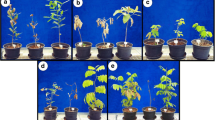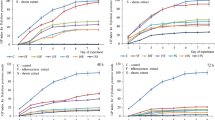Summary
Both extract as well as leachate ofCroton bonplandianum leaves before or after washing are detrimental to at least six weedy associates, viz.Calotropis procera, Chrysopogon aciculatus, Crotalaria saltiana, Cynodon dactylon, Eupatorium odoratum andPolygonum orientale.
By adding increasing quantities of decaying leaves to soil, phytotoxic activity is greatly enhanced against at leastCrotalaria saltiana, Cynodon dactylon andEvolvulus nummularius.
Soil samples collected in and aroundCroton bonplandianum plants during active growth of the species are more toxic to weedy associates than the soil collection made after accumulation of debris ofCroton plants. The weeds that are mostly affected includeChrysopogon aciculatus, Cynodon dactylon, Eupatorium odoratum, Evolvulus nummularius andMikania cordata.
Maximum amount of inhibitory compound fromCroton bonplandianum leaves are extractable in ethanol. The ethanol extract, on further analysis, leads to the finding that two active constituents are involved and that these constituents are probably related to abscisic or phaseic acid.
The implications of the above results are discussed.
Similar content being viewed by others
References
Abdul-Wahab, A. S. & E. L. Rice. 1967. Plant inhibition by Johnson grass and its possible significance in old-field succession. Bull. Torrey Bot. Club 94: 486–497.
Bode, H. R. 1958. Beiträge zur kenntnis allelopathischer Erscheinungen bei einigen Juglandaceen. Planta 51: 440–480.
Bonner, J. 1950. The role of toxic substances in the interaction of higher plants. Bot. Rev. 16: 51–65.
Börner, H. 1960. Liberation of organic substances from higher plants and their role in the soil sickness problem. Bot. Rev. 26: 393–424.
Datta, S. C. & S. P. Sinha-Roy. 1973. Germination and growth inhibitors in Croton bonplandianum, a perennial weed. Proc. 4th Asian-Pacific Weed Sci. Soc. Conf. 2: 485–488.
Datta, S. C. & S. P. Sinha-Roy. 1974. Allelopathy and inhibitors. Sci. & Cult. 40: 47–59.
Evenari, M. 1961. Chemical influences of other plants (allelopathy). In: Handbuch der Pflanzenphysiologie. Ed. W. Ruhland. 16: 691–736. Springer-Verlag, Berlin.
Le Tourneau, D. & H. G. Heggeness. 1957. Germination and growth inhibitors in leafy spurge foliage and quackgrass rhizomes. Weeds 5: 12–19.
Muller, C. H. 1953. The association of desert annuals with shrubs. Amer. J. Bot. 40: 53–60.
Muller, C. H. 1964. Volatile growth inhibitors produced by Salvia species. Bull. Torrey Bot. Club 91: 327–330.
Muller, C. H. 1966. The role of chemical inhibition (allelopathy) in vegetational composition. Bull. Torrey Bot. Club 93: 332–351.
Muller, C. H. 1970. Phytotoxins as plant habitat variables. In: Advances in Phytochemistry. Ed. C. Steelink & V. C. Runeckles. 3: 105–121. Appleton-Century-Crafts, New York.
Parenti, R. L. & E. L. Rice. 1969. Inhibitional effects of Digitaria sanguinalis and possible role in old-field succession. Bull. Torrey Bot. Club 96: 70–78.
Rice, E. L. 1967. Chemical warfare between plants. Bios. 38: 67–74.
Wilson, R. E. & E. L. Rice. 1968. Allelopathy as expressed by Helianthus annuus and its role in old-field succession. Bull. Torrey Bot. Club 95: 432–448.
Author information
Authors and Affiliations
Additional information
For nomenclature see Table 1.
We feel obliged to Prof. A. K. Sharma, Head of the Department of Botany, University of Calcutta, for providing the necessary facilities for this study. Grateful thanks are due to Prof. D. P. Chakravarty of the Bose Institute, Calcutta, for his kind advice in the chemical analysis of the plant extract; Prof. S. P. Sen of the University of Kalyani, West Bengal and Prof. M. Evenari of the Hebrew University of Jerusalem, Israel, for their valuable suggestions.
Rights and permissions
About this article
Cite this article
Datta, S.C., Sinha-Roy, S.P. Phytotoxic effects of Croton bonplandianum Baill. on weedy associates. Plant Ecol 30, 157–163 (1975). https://doi.org/10.1007/BF02389704
Accepted:
Issue Date:
DOI: https://doi.org/10.1007/BF02389704




